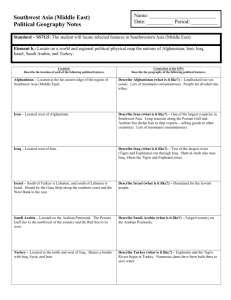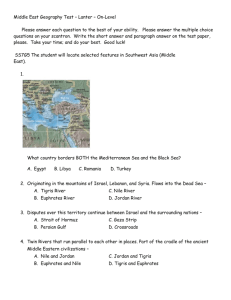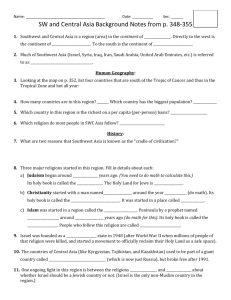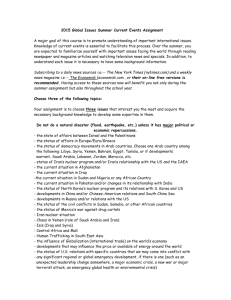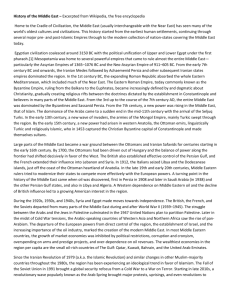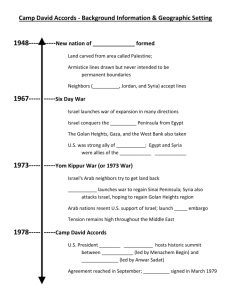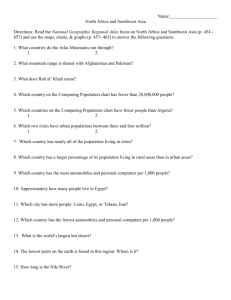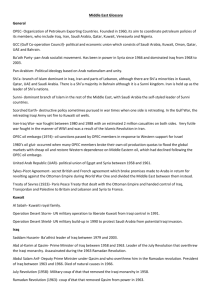Unit 7 Packet – Southwest Asia
advertisement
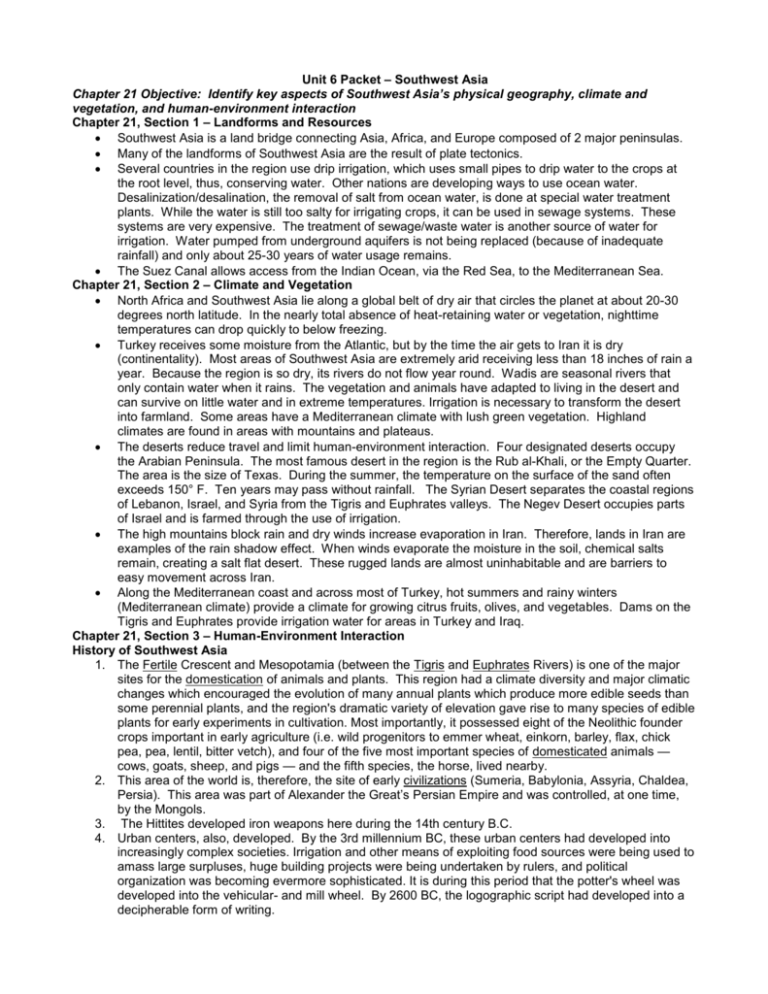
Unit 6 Packet – Southwest Asia Chapter 21 Objective: Identify key aspects of Southwest Asia’s physical geography, climate and vegetation, and human-environment interaction Chapter 21, Section 1 – Landforms and Resources Southwest Asia is a land bridge connecting Asia, Africa, and Europe composed of 2 major peninsulas. Many of the landforms of Southwest Asia are the result of plate tectonics. Several countries in the region use drip irrigation, which uses small pipes to drip water to the crops at the root level, thus, conserving water. Other nations are developing ways to use ocean water. Desalinization/desalination, the removal of salt from ocean water, is done at special water treatment plants. While the water is still too salty for irrigating crops, it can be used in sewage systems. These systems are very expensive. The treatment of sewage/waste water is another source of water for irrigation. Water pumped from underground aquifers is not being replaced (because of inadequate rainfall) and only about 25-30 years of water usage remains. The Suez Canal allows access from the Indian Ocean, via the Red Sea, to the Mediterranean Sea. Chapter 21, Section 2 – Climate and Vegetation North Africa and Southwest Asia lie along a global belt of dry air that circles the planet at about 20-30 degrees north latitude. In the nearly total absence of heat-retaining water or vegetation, nighttime temperatures can drop quickly to below freezing. Turkey receives some moisture from the Atlantic, but by the time the air gets to Iran it is dry (continentality). Most areas of Southwest Asia are extremely arid receiving less than 18 inches of rain a year. Because the region is so dry, its rivers do not flow year round. Wadis are seasonal rivers that only contain water when it rains. The vegetation and animals have adapted to living in the desert and can survive on little water and in extreme temperatures. Irrigation is necessary to transform the desert into farmland. Some areas have a Mediterranean climate with lush green vegetation. Highland climates are found in areas with mountains and plateaus. The deserts reduce travel and limit human-environment interaction. Four designated deserts occupy the Arabian Peninsula. The most famous desert in the region is the Rub al-Khali, or the Empty Quarter. The area is the size of Texas. During the summer, the temperature on the surface of the sand often exceeds 150° F. Ten years may pass without rainfall. The Syrian Desert separates the coastal regions of Lebanon, Israel, and Syria from the Tigris and Euphrates valleys. The Negev Desert occupies parts of Israel and is farmed through the use of irrigation. The high mountains block rain and dry winds increase evaporation in Iran. Therefore, lands in Iran are examples of the rain shadow effect. When winds evaporate the moisture in the soil, chemical salts remain, creating a salt flat desert. These rugged lands are almost uninhabitable and are barriers to easy movement across Iran. Along the Mediterranean coast and across most of Turkey, hot summers and rainy winters (Mediterranean climate) provide a climate for growing citrus fruits, olives, and vegetables. Dams on the Tigris and Euphrates provide irrigation water for areas in Turkey and Iraq. Chapter 21, Section 3 – Human-Environment Interaction History of Southwest Asia 1. The Fertile Crescent and Mesopotamia (between the Tigris and Euphrates Rivers) is one of the major sites for the domestication of animals and plants. This region had a climate diversity and major climatic changes which encouraged the evolution of many annual plants which produce more edible seeds than some perennial plants, and the region's dramatic variety of elevation gave rise to many species of edible plants for early experiments in cultivation. Most importantly, it possessed eight of the Neolithic founder crops important in early agriculture (i.e. wild progenitors to emmer wheat, einkorn, barley, flax, chick pea, pea, lentil, bitter vetch), and four of the five most important species of domesticated animals — cows, goats, sheep, and pigs — and the fifth species, the horse, lived nearby. 2. This area of the world is, therefore, the site of early civilizations (Sumeria, Babylonia, Assyria, Chaldea, Persia). This area was part of Alexander the Great’s Persian Empire and was controlled, at one time, by the Mongols. 3. The Hittites developed iron weapons here during the 14th century B.C. 4. Urban centers, also, developed. By the 3rd millennium BC, these urban centers had developed into increasingly complex societies. Irrigation and other means of exploiting food sources were being used to amass large surpluses, huge building projects were being undertaken by rulers, and political organization was becoming evermore sophisticated. It is during this period that the potter's wheel was developed into the vehicular- and mill wheel. By 2600 BC, the logographic script had developed into a decipherable form of writing. 5. 6. 7. 8. 9. 10. 11. 12. 13. 14. 15. 16. 17. 18. 19. 20. 21. 22. 23. Many of the people of the Arabian Peninsula were nomads/Bedouins who adapted to the harsh conditions of the desert and built a culture based on strong family ties. Many different belief systems have developed in this area. Judaism (1300 B.C.), Christianity (1A.D.), and Islam (622 A.D.) are monotheistic religions that continue in use today. Roman Empire controlled Judea, by 31 B.C.; Jews rebelled against the Romans. Jews fail to hold the fortress of Masada against the Romans in 73 A.D. The defeated Jews fled the area (diaspora – the movement of a cohesive group, ethnic, religious, or racial, out of an area). Islam is a religion based on the teachings of its founder, the Prophet Muhammad, who lived part of his life in Mecca. The nomads of the Arabian Peninsula, the Beduoin, were among the first converts to Islam. They were already spreading the faith by the time of Muhammed’s death in A.D. 632. Arabic language and Islamic teachings and culture spread across Southwest Asia. By the Middle Ages, a large area of the world was controlled by Muslim empires. The governments of lands controlled by Muslims were theocratic where religious leaders controlled the government. Rulers relied on religious law and consulted with religious scholars on running the country. Arabs remained the dominant elite as Islam spread, but they placed local non-Arabs and non-Muslims as administrators of newly taken territory. Thus, they allowed local rule but collected taxes that supported the empire. They were tolerant of Jews, Christians, and other monotheists. While Europe languished in the medieval period (A.D. 450-1400), Muslim scholars traveled extensively throughout Asia and Africa gathering information. They made important contributions in the field of history, mathematics, geography, medicine, and other academic disciplines, and also preserved many writings in their libraries. By the tenth century, people throughout the Arab-Islamic empire’s former territories had gradually converted to Islam and many adopted the Arabic language. But then the Arab-Islamic empire began to break apart into smaller units as outlying provinces, often ruled by a local Islamic dynasty, eluded the control of central authorities. From the 11th to the 15th centuries, Mongols from eastern Central Asia and other peoples conquered parts of Muslim territory. By the fifteenth century, the Ottoman Muslims defeated the Christian Byzantine Empire and took over its capital, Constantinople, which they renamed Istanbul. The Ottoman Turks expanded their empire to Egypt, in Africa, and into Austria, in Europe. By 1492, the Spanish forced the Muslims/Moors to leave Spain or convert to Roman Catholicism. Throughout the 19th century, North African lands began to change from Ottoman to European control. At first, European influence was exercised primarily through control of trade and finance. North Africa became a source of raw materials for Europe in a trading relationship dominated by European merchants, who sought the agricultural products—the cotton of Egypt, and the phosphates, manganese, hides, and wool of the western Mediterranean countries. Britain also wanted to control Egypt to protect the Suez Canal completed in 1869. In 1830, France became the first European country to exercise direct control of a North African territory when its military gained control of Algeria. France eventually administered Algeria almost as though it were a part of France—although Muslims were not allowed the benefits of full citizenship. In the late 1800s, France, Britain, and Italy raced to occupy several other North African countries, motivated in part by European power politics—the fear that a rival would step in first. In these colonies, Europeans set up a form of dependence that they termed a “protectorate” where local rulers remained in place, but European officials made the important decisions. Both during the 1800s and the 1900s, Europeans interfered with the idea of tribal land ownership. These traditional and more egalitarian (equal) systems of landownership were done away with. European officials privatized tribal collective lands and gave title to just the tribal leader in return for their political support. Thus, European domination disempowered the many and encouraged the concentration of wealth and power in the hands of a few. This income gap continues today. During WWI, the Ottomans allied with Germany and the Central Powers. After the war ended, the League of Nations allotted almost all former Ottoman territories at the eastern end of the Mediterranean to France and Britain for supervision. Only Turkey was recognized as an independent country. Palestine and Iraq (Jordan was created from a piece of Iraq) were under the control of Britain. In 1917, in response to Zionist pleas, the British government issued the Balfour Declaration, which committed Britain to support the establishment of “a national home for the Jewish people” in Palestine, but only if the civil and religious rights of non-Jewish communities in Palestine could be assured. The British establish Iraq as a monarchy in 1921 and placed on the throne the former King of Syria (who had been expelled by the French), King Faisal I of the Hashemite family. 24. The Arabs were upset because the Balfour Declaration was a breach of previous agreements that the British had with Arab leaders which had assured them of independent control over Arab lands. This breach is still cited as cause for distrusting the West. 25. A massacre of Jews by Arabs in 1929 resulted in the death of 133 Jews. 26. The British granted Iraq its independence in 1932 with the death of King Faisal. A series of military dictators followed. 27. In 1939, the British introduced the White Paper of 1939, which limited Jewish immigration to Palestine, over the course of the war, to 75,000 and restricted purchase of land by Jews. 28. The British took over the administration of Iraq again from 1941-1947. They feared that they would lose access to Iraqi oil. The British put the Hashemites back on the throne. The Hashemites would rule Iraq until 1958. 29. World War II led to further developments. As the U.S. gained status as a world power and to counter communism, it supported autocratic local leaders who were most sympathetic to U.S. policies (as opposed to USSR policies) and most likely to maintain a friendly attitude toward U.S. business interests. In Iran and Saudi Arabia, where vast oil deposits became especially lucrative by mid-century, European and U.S. oil companies played a key role in deciding who ruled. Oil profits were undertaxed and most of the profits were gathered by a small elite and spent on opulent living or invested abroad. Although some oil revenue went toward building roads, hospitals, and schools—facilities that had not previously existed—too little was invested in opening up opportunities for the masses. The region remained dependent on Europe and North America for the technology needed to exploit oil and begin the mechanization of manufacturing, transportation, and agriculture. During this period, the disparity in wealth between the elite and the majority of the people increased dramatically. 30. Because of the Holocaust, in 1947, the United Nations voted to recommend a partition plan that would divide the area of Palestine between Jews and Arabs with Jerusalem internationalized. The world wanted to repay the Jews by giving them some of their homeland back. 31. Following increasing levels of violence from Arab/Muslim groups, uncontrollable immigration from Europe and general war-weariness, the British government decided to withdraw from Palestine. 32. When the British left the area in 1948, Jewish leaders immediately created a Jewish state. 33. The Palestinians and their Arab neighbors had never accepted the U.N.’s decision. Egypt, Syria, and Jordan made war on the new state of Israel. 34. The West supplied arms to only one side: Israel. Israel won the war in 1948. 35. After the war, the Israelis evicted many Palestinians from their land 36. Many Palestinians fled Palestine creating pockets of refugees in neighboring countries. 37. In 1956, Egypt sealed the Suez Canal to Israeli shipping 38. In 1956, Israel invaded the Gaza Strip and the Sinai Peninsula. 39. Israel was persuaded by the major powers to evacuate the Sinai Peninsula (part of Egypt) 40. In 1958, the military took over control of Iraq and a series of dictators follow 41. In 1959, the Socialist Ba’athist Party took over control of Iraq—the minority Sunnis ruled. 42. In 1960, OPEC is formed (Organization of Petroleum Exporting Countries) as a cartel to control production and, therefore, the price of oil 43. In 1960, the Republic of Cyprus was formed with a Greek ethnicity 44. In 1964, Turkey attacked and now controls half of the island. The U.N. patrols the dividing line between the two factions (Green Line). The Turkish Republic of Northern Cyprus is not recognized as a state. 45. In 1964, the Palestinian Liberation Organization (PLO) formed to destroy the State of Israel, return to Palestine, and be allowed to govern themselves within Israeli held territory. Yasser Arafat was their leader from 1969 until 2004. 46. Six Day War a. In May of 1967, President Nasser of Egypt demanded that the UN remove their forces from the Sinai Peninsula. Egypt then closed Israel’s access to the Gulf of Aqaba and, therefore, cut off Israeli shipping. b. On June 5, 1967, Israel bombs and destroys the Egyptian, Jordanian, Iraqi, and Syrian Air Forces. c. The U.S. was deeply involved in the Vietnam War and other Western nations were hesitant to get involved because of the need for Arab oil. d. President Nasser, of Egypt, sank ships to make the Suez Canal inoperable. e. Israeli troops moved into the Sinai Peninsula, Golan Heights, West Bank, and Jerusalem. f. Nasser falsely claimed that the U.S. and British had destroyed his air force. 47. 48. 49. 50. 51. 52. 53. 54. 55. 56. 57. 58. 59. 60. 61. 62. 63. g. results: i. Israeli occupation of Arab national territory ii. Creation of fully developed and fanatic Palestinian nationalism iii. Allowed the Israelis to feel that they could ignore the military threats of the Arabs iv. Drove the moderate Arab states into a strictly anti-Israeli alignment v. Israel now had complete control of Jerusalem, a city holy to 3 religions Between 1968 and 1972, a period known as the War of Attrition, numerous scuffles erupted along the border between Israel and Syria and Egypt. Furthermore, in the early-1970s, Palestinian groups embarked on an unprecedented wave of attacks against Israel and Jewish targets in other countries. a. The climax of this wave occurred at the 1972 Munich Olympic Games, when, in the Munich massacre, Palestinian militants (Black September) held hostage and killed members of the Israeli delegation. b. Israel responded with Operation Wrath of God, in which agents of Mossad assassinated most of those who were involved in the Munich massacre. c. Finally, on October 6, 1973, on the Jewish fast day of Yom Kippur, the Egyptian and Syrian armies launched a surprise attack against Israel. However, despite early successes against an unprepared Israeli army, Egypt and Syria failed to accomplish their goal of regaining the territories lost in 1967. Yet after the war, a number of years of relative calm ensued, which fostered the environment in which Israel and Egypt could make peace. In 1973 and 1974, the Arab nations decided to punish the U.S. for its support of Israel cutting the supply of oil (prices rose and shortages occurred in the U.S.) through OPEC. USSR threatened to intervene in the Middle East and the US, to avoid a nuclear confrontation, helped broker peace. Henry Kissinger, U.S. Secretary of State, met with President Sadat, of Egypt, on November 7, 1973, on January 18, 1974 and again on March 18, 1974 to reestablish relations that had been broken since 1967; arrange for an exchange of Jewish and Arab prisoners; provide for a mutual disengagement; set up a U.N. buffer force near the Suez; lifted the oil embargo; and set boundaries. In 1977 and 1979, former U.S. President, Jimmy Carter, met with Sadat and Menachim Begin, Prime Minister of Israel, and Egypt agreed to recognize Israel as a country (Camp David Accords), and settle peace agreements. The treaty did not address Jewish settlers in the West Bank and Golan Heights, but did require the withdrawal of the Israelis from the Sinai. In 1979, Saddam Hussein became president of the Ba’athist controlled Iraq. In 1979, the secular leader of Iran was ousted by the Islamists and the Ayatollah Khomeini took over and began instituting sharia. Anyone opposing the new theocratic state was imprisoned or executed. Women who had had freedom under the secular state were once again restricted. This fundamentalist attitude is seen as a way to counter the unwelcome effects of Western influence. In 1979, Russia invaded Afghanistan fearing that the religious revolution in Iran would spread to the Central Asian states in the USSR. In 1979, the US CIA began training mujahadeen (anti-Soviet forces) to help keep Afghanistan from becoming communist. In 1981, Egyptian President Sadat was assassinated by Egyptian terrorists who did not want peace with Israel. 1982, PLO sets up housekeeping in Lebanon 1987, First Intifada – uprising against Israel 1980-1988 – Saddam Hussein attacked Iran to gain access to more land on the Persian Gulf. The prolonged war hurt both countries’ economy and infrastructure. The war had 4 dimensions: a. ethnic – Arab vs. Persian b. political - secular vs. theocratic c. religious – Sunni vs. Shiite d. economic – control of oil The US aided Iraq during the Iran/Iraq War. From 1983-1990, the US send $5 billion in aid to Iraq. In 1989, the Soviets will finally withdraw from Afghanistan. In 1990, Suddam Hussein invaded Kuwait. The Persian Gulf War led to the freeing of Kuwait. Economic sanctions were put in place on Iraq pending Hussein allowing weapons inspections. Hussein never fully allowed inspections. The Taliban takes over control of Afghanistan in 1993--imposing strict rules. In 1993, the Israeli Prime Minister, Rabin, and Yasir Arafat, leader of the PLO, signed a historic peace treaty call the Oslo Accords. Palestinians were granted self-rule in the Gaza Strip and parts of the West Bank. Jewish settlers in these areas felt betrayed. 64. The Palestinians continued to hope for a Palestinian state. In 1996, Palestinian terrorists (Hamas) bombed Jerusalem and Tel Aviv, killing innocent Jewish civilians. 65. In return, the government of Israel bombed Palestinian refugee camps in Lebanon. Many innocent civilians were killed. Israel refused to withdraw troops from the West Bank and refused to discuss the creation of a Palestinian state. 66. In September 2000, the Second Intifada , with terrorism and suicide bombings, began to force Israel to talk about creating a Palestinian state. 67. Barak, Prime Minister of Israel, and Yassir Arafat, leader of the PLO, once again conducted negotiations with President Clinton at the July 2000 Camp David summit. However, the talks failed. 68. In 2001, al Qaeda operatives bombed several sites in the US. As a result, the US invaded Afghanistan to find the al Qaeda leaders and remove the Taliban from power because of their support of the terrorists. A democratic government was put in place. 69. In 2003, the US then invaded Iraq with the idea of capturing Hussein’s WMDs and removing Hussein from a position of being able to support terrorists. 70. In 2004, Yasser Arafat died. 71. In 2005, the Israelis evacuated the Gaza Strip and allowed Palestinians to take complete control; negotiations are going forward regarding the West Bank. 72. The 2006 Palestinian election resulted in Hamas candidates becoming the majority in the Palestinian government 73. The 2006 Israel-Lebanon conflict refers to the military conflict in Lebanon and northern Israel, primarily between Hezbollah and Israel, which started on the 12th of July. The conflict began with cross-border Hezbollah raid and shelling, which resulted in the capture of two and killing of three Israeli soldiers. Israel held the Lebanese government responsible for the attack, as it was carried out from Lebanese territory, and initiated an air and naval blockade, airstrikes across much of the country, and ground incursions into southern Lebanon. 74. A ceasefire came into effect on the 14th of August, although violations of the ceasefire occurred on both sides. The conflict killed over 1000 Lebanese civilians, 440 Hezbollah militants, and 119 Israeli soldiers, as well as, 44 Israeli civilians and caused massive damage to the civilian infrastructure and cities of Lebanon and damaged thousands of buildings across northern Israel, many of which were completely destroyed 75. In 2006, the US suspended aide ($) to Palestinian government which was led by the fundamentalist Hamas faction. 76. In 2007, peace talks were held in the U.S. Chapter 22, Section 1 – The Arabian Peninsula 76. The Arabian Peninsula, as a subregion, consists of Bahrain, Kuwait, Oman, Saudi Arabia, Qatar, United Arab Emirates, and Yemen. 77. Saudi Arabia a. The tight control of the ruling family and conservative clerics has inhibited the development of opportunities for young people. King Abdullah ranks #4 of the World’s Worst Dictators for a punitive justice system (young teens can be sentenced to death and defendants tortured); women are more oppressed in Saudi Arabia than any other country (women can’t even receive medical are without a male guardian’s permission). b. Discontent among young adults is rising and their discontent is often expressed by embracing fundamentalist Islam (Islamists). c. Saudi Arabia now provides education in gender-segregated schools. d. Increasing numbers of women work outside their homes. Although women are active in most, if not all five of the professions as well as such commercial activities as banking and some retail trade, they do not drive cars or travel alone and social encounters are segregated. Within samesex encounters, however, the normally reserved Saudis are much more tactile than westerners in their behavior. 78. Economy a. Arabian Peninsula nations make almost all of their export money and a large share of GDP from oil, so oil prices are very important to them. Large increases in oil prices allow the oil-producing nations to funnel money into development of other parts of their economy, especially water development projects. b. Omar, Qatar, and Bahrain i. Oil in Oman and Qatar generate relatively high standards of living. The emir of Qatar and his wife are generous patrons of education and support social reform. ii. Bahrain, virtually a city-state, generates income not from its tiny oil reserves but from services related to oil production and transport and from providing entertainment, shopping, and manufactured goods for neighboring wealthy Saudis. c. Yemen has not taken advantage of its oil reserves. Yemen’s standard of education and living remain the lowest in the region of The Arabian Peninsula. Chapter 22, Section 2 – The Eastern Mediterranean 65. The Eastern Mediterranean region of Southwest Asia includes Cyprus, Lebanon, Syria, Jordan and Israel. 66. All three major monotheistic religions claim Jerusalem in Israel as a holy city and as a result the nations of the eastern Mediterranean have been plagued with a history of political tension and unrest. 67. Political divisions, refugees, lack of water, and a weak infrastructure make it difficult to develop healthy economies. 68. Civil wars between the Christians and Muslims or Jews and Muslims have interrupted development. 69. Economic Development l. All of the nations of this subregion have great potential for development. They have a good climate for producing citrus crops and many places for tourists to visit. They are well located for connections to international trade in Europe, Asia, and Africa. m. The National Water Carrier Project in Israel carries water from the northern part of the country to the central and southern parts. Chapter 22, Section 3 – The Northeast 70. The nations of this subregion include Turkey, Iran, Iraq, and Afghanistan. They are mostly Muslim in religion, but only Iraq is Arabic culturally. 71. Internal clashes over land plague several of the nations. The Kurds have been called a stateless nation (without a land to legally occupy). They claim a homeland in parts of Turkey, Iran, and Iraq. 72. The nations in this subregion face a variety of economic challenges. All of them have limited agricultural land. Most of these nations have oil or natural gas resources that can generate revenue (income). This money is needed to update and expand transportation systems, communications systems, power generation plants, and water and sanitation systems. 73. Turkey n. Turkey is developing its water resources and hydroelectric plants to supply energy and to boost production of cotton and other agricultural products. Turkey’s dams on the Euphrates have created tensions with Syria and Iraq. o. Turkey wants to be part of the European Union because of its location. Turkey’s human rights record, fights with Greece over territory, and the death penalty have prevented its inclusion in the EU p. Because of its location, Turkey is a member of NATO (North Atlantic Treaty Organization). 74. Iran r. The current government in Iran supports economic growth. Oil money fuels most of the plans for developing a diversified economy. However, Iran is still recovering from a war with Iraq. s. There is some concern by the major powers of the world over Iran’s use of nuclear materials. t. The Sayyid Ali Khamenei ranks 7th of the World’s Worst Dictators. While Iran has a president, the Ayatollah Khamenei controls the country. In 2007, officials carried out public hangings, stoned a man to death for adultery, shut down music studios and cafes, and persecuted dissidents. u. Partly because of its location, Iran is the country with the largest number of international refugees—more than 2.21 million. More than 60,000 are Iraqis who fled the regime of Saddam Hussein; about a quarter are Kurds fleeing Turkey and Iraq, and 1.3 million are Afghans who left during the Soviet invasion of Afghanistan, the subsequent Taliban regime, and most recently U.S. occupation. 75. Afghanistan is one of the poorest nations on earth. Most of its people are engaged in subsistence farming and herding. It lacks efficient transportation to get products to market. The mineral resources in Afghanistan are not utilized because of a lack of workers with technical skills. Religion 76. Muslims – Koran/Qu’ran; Muhammed; Allah a. Religious duties – the Five Pillars i. Faith – All believers must testify to the following statement of faith: “There is no God but Allah, and Muhammad is the Messenger of Allah.” ii. Prayer – Five times a day, Muslims face toward the holy city of Mecca to pray. They may do this at a place of worship called a mosque or wherever they find themselves at the prayer times. iii. Charity – Muslims believe they have a responsibility to support the less fortunate by giving money for that purpose. iv. Fasting – During the Islamic holy month of Ramadan, Muslims do not eat or drink anything between sunrise and sunset. This action reminds Muslims that there are things in life more important than eating. It is also a sign of self-control and humility. v. Pilgrimage – All able Muslims are expected to make a pilgrimage (hajj) to Mecca at least once during their lifetimes. b. Sunnis and Shiites disagree on the interpretation of the Koran, particularly with regards to who leads the religion. Shiites say that it has to be a descendant of Mohammed. Sunnis make up @85% of the world’s Muslims. Chapter 23, Section 1 – Population Issues Relocation (Migration and Urbanization) 77. Life in Southwest Asia in 1900 seemed only slightly different from life there in 1100s. Some people lived in villages or cities while others moved livestock from one source of water to another. Then in the early years of the 20th century, everything changed. Geologists discovered huge deposits of petroleum and natural gas under the sands and seas of Southwest Asia. 78. Many countries in the area grew enormously wealthy from oil profits. The oil boom set off decades of rapid urbanization. Many thousands of people migrated to the cities in search of jobs and a chance to share in the regions newfound riches. To fill job openings, companies recruit people, mostly from South and East Asia. These guest workers are largely unskilled laborers. They fill jobs that the region’s native peoples find culturally or economically unacceptable (3-D jobs: dirt, demanding, and dangerous). Other guest workers are in demand for the skills they have. 79. The presence of many guest workers has led to problems. Cultural differences often exist between the guest workers and their employers. Misunderstandings over certain customs can result in severe penalties. For example, a Filipino man was given six months in jail and expelled from the UAE for brushing past a woman on a bus. Arabs viewed his behavior as insulting to the woman. Sometimes the workers must live in special districts, have been abandoned, receive no wages and find themselves unemployed and without the money to get back home. Some governments worry that depending on guest workers will prevent their nation’s own workers from developing their skills. Others worry about the intolerance and violence that these workers face. And, finally, some fear the immigrants could weaken their country’s sense of national identity. 80. One of the longest conflicts has been with the Kurds who have occupied areas of Turkey, Iraq, and Iran for the past 1,000 years. The Kurds exist without a nation and resist control in each of the countries. The Iraqi government used deadly chemical weapons on settlements of Kurds to kill them or force them to leave the area. Many Kurds have been forced to live in crowded relocation camps. 81. Some regions experience migration as populations look for jobs. Most of those migrants are young men, because women typically do not travel widely, or on their own. Several million are guest workers in Europe. Remittances, earnings sent home, to their families in North Africa, Turkey, or Lebanon significantly increase local standards of living. 82. Refugee camps often become semipermanent with their own communities and informal economy. Many refugees have fled war or environmental disasters; others become refugees because of political conflicts. An even larger group of people are refugees within their home countries, usually because of civil unrest. Patterns 83. In the 1960s, when most women married shortly after reaching puberty, some countries had average fertility rates of 9 children per woman. By 2001, as literacy rates rose, and the average women did not marry until age 21, the average fertility rate for the region was reduced to just under 4 children per woman. Nonetheless, this rate is still higher than the world average of 2.8. Only Africa’s fertility rate is higher. In Iraq and Saudi Arabia, fertility rates are still 5 children per woman. One result is that well over 40% of the population is under age of 15 in Iraq, Jordan, Palestine, Saudi Arabia, Syria, Yemen, and Sudan. Population will continue to grow rapidly as these children reach reproductive age, even if each couple has only 2 children. 84. There is a culturally entrenched preference for sons. Because of their wider opportunities, sons are better positioned to increase the family wealth and social standing. Sons are expected to support their parents financially in their retirements. The strong preference for sons means that families sometimes continue having children until they have a sufficient number of sons. 85. At present rates of growth, it is difficult to imagine how the area will support the additional people. Fresh water is already in extremely short supply, and most countries must import food at great cost. Furthermore, 32 million more jobs would have to be created within the next decade to employ the added population. If women start entering the workforce, even more new jobs will be needed. Gender Roles 86. In urban contexts, especially where women have opportunities outside the home—to obtain knowledge, wages, or prestige on the job, or to participate in civil society—they almost always choose to have fewer children. Where women are secluded in the home and undereducated, they have little chance to accumulate wealth or to enhance the prospects and reputation of the family in ways other than having children. 87. Generally, in societies of this region, particularly those that are Islamic theocratic, women are thought to be less responsible, more ruled by emotion than logic, and more likely to submit to sexual temptation than men. The effect of this prevailing view has been to seclude women from public life in order to regulate their whereabouts and make them inaccessible to the public gaze. Seclusion, in turn, is part of the geography for women that is different from men. Because they are to remain secluded, women typically perform tasks that will not require their presence in public spaces and, therefore, their daily lives become associated with domestic spaces. Men are not required to be secluded, thus public space and an associated set of tasks and opportunities are not off limits to them. 88. In Islamic society, women are typically expected to operate from, and are culturally assigned obligations within, private, domestic spaces. Housing and dress are designed to maintain this secluded role of women. Home open onto an inner courtyard, where women perform duties outside and yet remain cloistered from public spaces. Window treatments, such as shutters or latticework, may allow a female to look out onto the street while preventing those on the street from being able to view her. The veil and long, flowing robes, which are common attire for women in North Africa and Southwest Asia, allow women to operate outside of the home, yet remain secluded from the public gaze. Chapter 23, Section 2 – Economics 89. Over time, pressure and heat transformed the dead microscopic plant and animals that mixed with the sand and mud on the bottom of the sea and created hydrocarbons —the chemical basis for oil and natural gas. The oil or gas is trapped in the pores of rock and are prevented from moving out of the area by nonporous rock layers. Petroleum that has not been processed is called crude oil. Crude oil must be moved to a refinery by pipelines or tankers. There is always a risk of oil spills. 90. Oil has become a resource so vital that nations will go to war to ensure its steady supply—a strategic commodity. By the year 2020, Southwest Asia will probably provide 50 % of the world’s oil supply. One problem in relying on oil is that the world’s oil prices rise and fall unpredictably. As a result, countries can’t plan on income and it is difficult to sustain economic growth. 91. OPEC (Organization of Petroleum Exporting Countries) was created in 1960 to coordinate policies (control prices) on selling petroleum products. The group generally sets worldwide oil prices. Iran, Iraq, Kuwait, Saudi Arabia, Venezuela, Qatar, Libya, Indonesia, United Arab Emirates, Algeria, Nigeria, and Gabon are members of OPEC. 92. The oil-rich nations of Southwest Asia must decide how to use oil profits to benefit their countries. The region has to improve its infrastructure. Saudi Arabia has built new roads in rural areas, irrigation networks, and facilities to store agricultural products, as well as, desalinization plants. Other nations have constructed airports, shopping malls, and port facilities. A technology system has been created to allow companies and governments to conduct business in the region. 93. Some nations are developing other mineral resources. Oman has revived its copper industry and chromium mines, thus, reducing its dependence on oil profits. 94. Southwest Asian nations are developing their human resources (skills and talents of the people of a nation). Many of those nations also realize that they must invest in all their people, including women. Providing education and technology training is critical. The shortage of workers has opened opportunities for women. 95. Remittances, in the amount of $29 billion, went to Southwest Asia in 2006.

